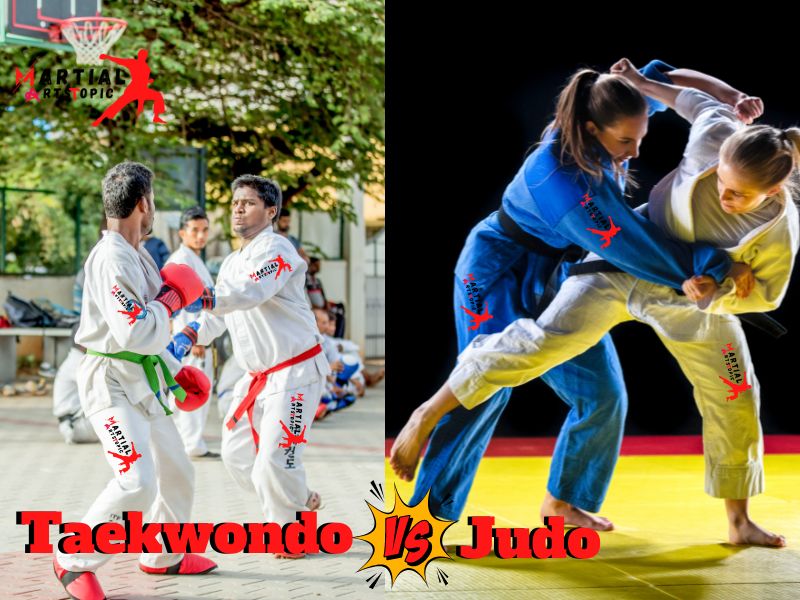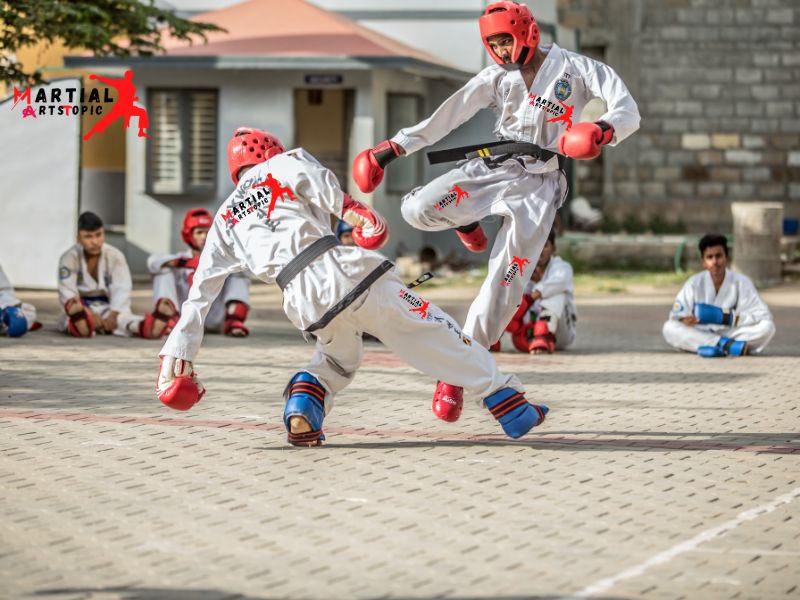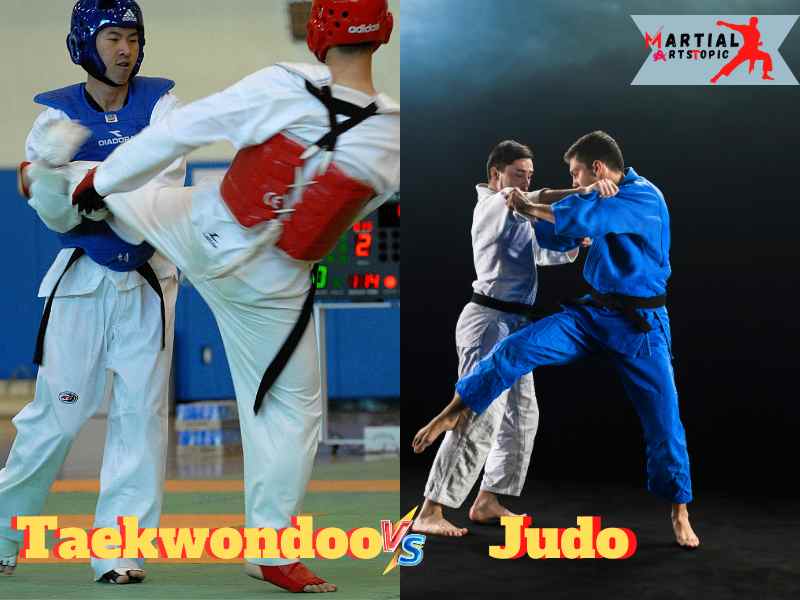
Why Taekwondo is Best Martial Art for Self-Defense
Taekwondo vs Judo: Why Taekwondo is Best Martial Art for Self-Defense When it comes to choosing a martial art for self-defense, many people are torn between Taekwondo and Judo. While both are excellent forms of self-defense, Taekwondo has proven to be the best choice for those looking to defend themselves in real-life situations.
Taekwondo is All About Striking
One of the major differences between Taekwondo and Judo is that Taekwondo is a striking-based martial art, while Judo focuses on throws and grappling techniques. In self-defense situations, striking is often more effective than grappling, because it allows you to keep your distance from your attacker and defend yourself from a safe distance. Taekwondo practitioners are trained to deliver powerful strikes to vulnerable areas of the body, such as the head, throat, and groin, which can quickly incapacitate an attacker.
Taekwondo Teaches Effective Kicking Techniques
Another advantage of Taekwondo over Judo is that it teaches highly effective kicking techniques. Taekwondo practitioners are trained to deliver fast and powerful kicks that can knock down an attacker or create enough distance to escape. Kicking techniques are particularly effective in self-defense situations because they allow you to keep your hands free to defend against other attacks.
Taekwondo Improves Physical Fitness
In addition to its practical self-defense techniques, Taekwondo is also an excellent way to improve your physical fitness. Taekwondo training involves a lot of cardiovascular exercise, which improves your endurance and overall fitness. Furthermore, Taekwondo can help you develop greater flexibility, balance, and coordination, which are essential for effective self-defense.
Taekwondo Teaches Self-Discipline and Self-Control
Taekwondo is not just about physical training; it also teaches important mental skills, such as self-discipline and self-control. Practitioners of Taekwondo learn to control their emotions and remain calm under pressure, which is essential in a self-defense situation. Moreover, Taekwondo emphasizes the importance of respecting others and avoiding conflict which can help you avoid dangerous situations altogether.
Taekwondo is Effective Against Multiple Attackers
Finally, Taekwondo is an effective martial art for self-defense against multiple attackers. Taekwondo practitioners are trained to defend themselves against multiple attackers by using their surroundings to their advantage, such as walls or other obstacles, and by using fast and powerful techniques to quickly incapacitate their attackers.
What is Taekwondo?
Taekwondo is a popular Korean martial art known for its dynamic kicks and fast-paced movements. It’s not just about physical techniques; it also emphasizes mental discipline, self-control, and respect for others. Taekwondo practitioners develop strength, flexibility, and agility while also honing their focus and perseverance. The art has a rich history and is recognized as an Olympic sport, showcasing its global appeal and competitive nature. Whether you’re interested in self-defense, fitness, or personal development, Taekwondo offers a holistic approach to martial arts that can benefit people of all ages and abilities.
Taekwondo Origins

Taekwondo has a rich history that dates back over 2,000 years. It was first developed in Korea as a means of self-defense against invading forces. Over the years, Taekwondo has developed and become more refined, with different styles and techniques being developed.
The word Taekwondo can be broken down into three parts: “tae” meaning foot, “kwon” meaning fist, and “do” meaning way or path. This reflects the focus of Taekwondo on using the hands and feet in combat.
The Philosophy and Principles of Taekwondo
At its core, Taekwondo is about more than just self-defense. It is a way of life that emphasizes discipline, respect, and perseverance. The philosophy of Taekwondo is based on five tenets: courtesy, integrity, perseverance, self-control, and indomitable spirit.
They instilled these principles in students from the very beginning of their training. We expect taekwondo practitioners to follow a strict code of conduct both inside and outside of the Dojang (training hall). This includes treating others with respect, being honest and humble, and striving for excellence in all areas of life.
Taekwondo vs Judo
While both Taekwondo and Judo are martial arts, they are quite different in terms of their focus and techniques. Judo emphasizes throws and grappling, while Taekwondo focuses on striking and blocking with the hands and feet.
In terms of self-defense, they considered Taekwondo to be more effective than Judo. This is because it allows practitioners to keep their distance from attackers and strike quickly and decisively. Taekwondo is also a substantial form of exercise, providing a full-body workout that improves strength, flexibility, and cardiovascular fitness.
Why Taekwondo is the Best Martial Art for Self-Defense
There are many reasons why Taekwondo is the best martial art for self-defense. Firstly, it teaches practitioners to be quick, enabling them to avoid attacks and strike back quickly. Secondly, Taekwondo emphasizes the use of kicks, which can be extremely effective in a self-defense situation. Kicks are powerful and can be delivered from a distance, allowing practitioners to keep their attackers at bay.
In addition, Taekwondo teaches practitioners to be confident and assertive, which can be a powerful deterrent to potential attackers. By developing a strong sense of self-confidence, Taekwondo practitioners are less likely to be targeted by bullies or other aggressive individuals.
Taekwondo is a martial art with a rich history and a deep philosophy. It is a powerful tool for self-defense and can help practitioners develop strong physical and mental discipline. Whether you are looking to improve your fitness, learn self-defense, or simply explore a new hobby, Taekwondo is an excellent choice.
What is Judo?

Judo is a dynamic martial art that originated in Japan and was developed by Jigoro Kano in the late 19th century. It emphasizes grappling and throwing techniques to overcome opponents, making it an effective self-defense system. Judo also focuses on the concept of using an opponent’s strength and momentum to your advantage, making it an ideal martial art for individuals of all ages and physical abilities. With its emphasis on discipline, respect, and mental fortitude, Judo not only hones physical skills but also cultivates a strong mindset. Whether you’re looking to improve your fitness, self-defense capabilities, or simply seeking a new challenge, Judo offers a holistic approach to personal growth and development.
Judo and its origins
Jigoro Kano, a Japanese educator and martial artist, developed judo in the late 1800s. Kano was interested in the physical and mental benefits of martial arts, but also recognized the need for a safer, more practical approach to training. He studied several martial arts and created Judo by combining elements of traditional Japanese jujitsu with his own ideas.
Judo quickly gained popularity in Japan and spread around the world, with the first international Judo tournament held in 1951. Today, Judo is recognized as an Olympic sport and is practiced by millions of people worldwide.
The philosophy and principles of Judo
At its core, Judo is more than just a sport or self-defense system. It is a philosophy and way of life that emphasizes personal growth and development. The principles of Judo are based on the concept of “maximum efficiency with minimum effort,” or “ju yoku go wo seisu” in Japanese., this means that Judo practitioners should use their opponent’s strength and momentum to their advantage, rather than relying solely on their own power.
In addition to this principle, Judo also emphasizes mutual respect, discipline, and the pursuit of personal excellence. They encouraged judo practitioners to treat their opponents with respect and to approach training with humility and an open mind. They are also taught to set and work towards personal goals, both in and out of the dojo.
Taekwondo vs Judo: Comparison
Taekwondo vs Judo: Comparison martial arts are a great way to stay fit, learn self-defense, and improve discipline. Taekwondo and Judo are two of the most popular martial arts around the world. They are both great options for those looking to learn a new skill, stay in shape, or compete in tournaments. In this blog post, we will compare Taekwondo vs Judo, including their techniques, styles, and rules.
Techniques
Taekwondo is a Korean martial art that emphasizes kicking techniques. We know it for its powerful and fast kicks, as well as its acrobatic jumping and spinning kicks. In Taekwondo, students learn a variety of kicks, including roundhouse kicks, front kicks, side kicks, and hook kicks. They also learn hand strikes, blocks, and joint locks.
On the other hand, Judo is a Japanese martial art that emphasizes throws and grappling techniques. We know it for its throws, sweeps, chokes, and joint locks. In Judo, students learn how to use their opponent’s momentum against them and how to take them down to the ground.
Styles
Taekwondo has two dominant styles: ITF (International Taekwondo Federation) and WTF (World Taekwondo Federation). ITF Taekwondo is more traditional and focuses on self-defense techniques, while WTF Taekwondo is more sport-oriented and emphasizes competition sparring.
Judo also has two dominant styles: Kodokan Judo and Brazilian Jiu-Jitsu (BJJ). Kodokan Judo is the traditional style and focuses on throws and grappling techniques. BJJ is a more modern style that emphasizes ground fighting and submissions.
Rules
Both Taekwondo and Judo have specific rules for competition. In Taekwondo, competition sparring is based on points. They awarded points for kicks and strikes to the head and body, and the first person to reach a certain number of points wins the match.
In Judo, competition is based on throws and submissions. The goal is to throw your opponent to the ground or submit them with a joint lock or choke. They won the match by scoring an ippon, a full point, or by accumulating smaller points.
Similarities and Differences
Although Taekwondo and Judo are different martial arts, they also have some similarities. Both martial arts emphasize respect, discipline, and self-control. They also require a lot of practice and dedication to master.
One major difference between the two martial arts is their focus. Taekwondo focuses more on striking techniques, while Judo focuses more on throws and grappling techniques. Another difference is their origins. Taekwondo originated in Korea, while Judo originated in Japan.
Why Taekwondo is Best?
Taekwondo vs Judo: Why Taekwondo is Best?Taekwondo and Judo are two popular martial arts that have been around for many years. Both disciplines have their unique features and advantages, but when it comes to which one is best, the answer is simple – Taekwondo. In this blog post, we will explore the advantages of Taekwondo over Judo, the physical and mental benefits of practicing Taekwondo, and provide examples of successful Taekwondo practitioners.
Advantages of Taekwondo over Judo

When it comes to martial arts, each discipline has its own advantages and disadvantages. Taekwondo has several advantages over Judo, including:
- Striking Techniques: Taekwondo is primarily a striking martial art, so it focuses on punching and kicking techniques. Judo, on the other hand, is mainly a grappling martial art that involves throws and takedowns.
- Speed and Agility: Taekwondo emphasizes speed and agility, which makes it an excellent martial art for self-defense. The fast and powerful kicks and punches of Taekwondo can be used to keep an attacker at bay and can even be used to immobilize them.
- Olympic Sport: Taekwondo is an Olympic sport, so it has a higher level of competition. This makes it a great martial art for those who want to compete at the highest levels.
Physical and Mental Benefits of Practicing Taekwondo
Practicing Taekwondo has numerous benefits, both physical and mental. Some of the physical benefits include:
- Improved Flexibility: Taekwondo involves a lot of stretching, which helps to improve flexibility and range of motion.
- Increased Strength and Endurance: Taekwondo is a high-intensity martial art that requires a lot of physical exertion. This helps to build strength and endurance.
- Weight Loss: Taekwondo is an excellent way to burn calories and lose weight. Practicing Taekwondo regularly can help you to achieve your weight loss goals.
In addition to the physical benefits, Taekwondo also provides several mental benefits, including:
- Improved Confidence: Practicing Taekwondo can help to improve self-confidence and self-esteem.
- Stress Relief: Taekwondo is an excellent way to relieve stress and tension.
- Improved Focus: Taekwondo requires a lot of focus and concentration, which can help to improve mental clarity and focus.
Why Taekwondo is the best choice
While both Taekwondo and Judo have their strengths, it is clear that Taekwondo is the best choice for martial arts enthusiasts. Taekwondo is a versatile, dynamic, and effective martial art that can be applied in various contexts. It also offers numerous physical and mental benefits that can improve practitioners’ overall health and well-being. With its rich history and tradition, Taekwondo is a martial art that has stood the test of time and continues to be a popular choice for people of all ages and backgrounds.
Successful Taekwondo Practitioners
There have been many successful Taekwondo practitioners over the years, including:
- Steven Lopez: Steven Lopez is a two-time Olympic gold medalist in Taekwondo.
- Hadi Saei: Hadi Saei is a four-time Olympic medalist in Taekwondo, including two gold medals.
- Jade Jones: Jade Jones is a two-time Olympic gold medalist in Taekwondo and a three-time world champion.
FaQs
How does Taekwondo compare to Judo?
Taekwondo and Judo are both martial arts that focus on self-defense and physical fitness. However, the two arts differ in their approach to combat. Taekwondo is a striking art that emphasizes kicks, punches, and blocks, while Judo is a grappling art that focuses on throws, holds, and joint locks.
What are the advantages of Taekwondo over Judo?
One of the advantages of Taekwondo over Judo is that it is a more effective striking art. Taekwondo practitioners are trained to deliver powerful kicks and punches that can incapacitate an opponent quickly. Additionally, Taekwondo training can help improve your balance, coordination, and flexibility.
Can Taekwondo help improve my physical fitness?
Yes, Taekwondo is a great way to improve your physical fitness. Taekwondo training involves a lot of cardio and strength training exercises that can help you build muscle, burn fat, and improve your overall health.
What are the mental benefits of practicing Taekwondo?
In addition to the physical benefits, Taekwondo training can also help improve your mental health. Taekwondo is a discipline that requires focus, discipline, and dedication. Practicing Taekwondo can help you build self-confidence, relieve stress, and improve your mental toughness.
How can I get started with Taekwondo training?
The best way to get started with Taekwondo training is to find a local Taekwondo school or gym. Look for a school that has experienced instructors and a positive learning environment. You can also find Taekwondo training videos and tutorials online.
Can anyone practice Taekwondo, regardless of age or fitness level?
Yes, anyone can practice Taekwondo regardless of their age or fitness level. Taekwondo is a versatile martial art that can be adapted to suit the needs of individuals of all ages and fitness levels.
What are some successful examples of Taekwondo practitioners?
Some successful examples of Taekwondo practitioners include Steven Lopez, Hadi Saei, and Jade Jones. These athletes have won multiple Olympic medals and are considered to be among the best Taekwondo fighters in the world.
How does Taekwondo training promote discipline and focus?
Taekwondo training promotes discipline and focus through the use of traditional training methods and rituals. We expect taekwondo practitioners to show respect to their instructors and fellow students, and to follow a strict code of conduct.
Can Taekwondo help me defend myself in real-life situations?
Yes, Taekwondo training can help you defend yourself in real-life situations. Taekwondo techniques are designed to be practical and effective in self-defense situations. With proper training, you can learn to defend yourself against attackers and protect yourself from harm.
What are the different levels of Taekwondo training and how do they work?
They divided Taekwondo training into different levels, or belts, that signify a practitioner’s level of skill and experience. The belt system typically begins with a white belt and progresses through different colors, such as yellow, green, blue, red, and black. As you progress through the ranks, you will be required to demonstrate mastery of different techniques and forms.
How does Taekwondo differ from Judo?
Taekwondo and Judo differ in their approach to combat. Taekwondo is a striking art that focuses on kicks, punches, and blocks, while Judo is a grappling art that emphasizes throws, holds, and joint locks.
Can Taekwondo help with self-defense?
Yes, Taekwondo can help with self-defense. Taekwondo techniques are designed to be practical and effective in real-life self-defense situations.
How long does it take to become proficient in Taekwondo?
The amount of time it takes to become proficient in Taekwondo varies depending on the individual. With regular practice and dedication, it is possible to become proficient in Taekwondo within a few years.
Are there any age restrictions for practicing Taekwondo?
No, there are no age restrictions for practicing Taekwondo. Taekwondo is a martial art that individuals of all ages can practice.
What equipment I needed for Taekwondo training?
The equipment needed for Taekwondo training typically includes a uniform, or dobok, and protective gear such as gloves, shin guards, and a head guard. Some schools may also require students to have a mouth guard and groin protector.
Conclusion
While both Taekwondo and Judo are fantastic martial arts with their own unique strengths and techniques, Taekwondo emerges as the better option for self-defense and overall fitness. Taekwondo’s emphasis on powerful kicks and strikes, combined with its focus on speed and agility, make it an ideal choice for anyone looking to improve their physical and mental health. Moreover, Taekwondo’s emphasis on self-discipline and respect instills important values that can be carried outside of the dojo and applied to everyday life. Ultimately, Taekwondo’s combination of physical fitness, self-defense skills, and character development make it a standout martial art that is well worth considering for anyone looking to try something new.
